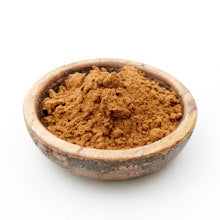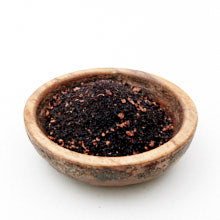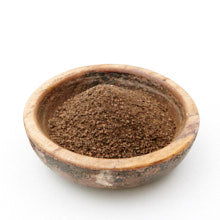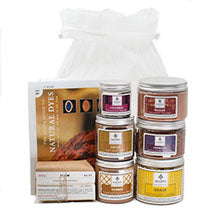
The natural dyes that we sell are termed exotic, historic, or classic. They yield good to excellent wash and light fastness when used in proper combination with mordants. We use them in our own studio and in our naturally dyed clothing.
A full palette of colours can be achieved by varying the mordants and by blending dyes together (such as cutch and cochineal, or cochineal and madder, or madder and logwood). Overdying with indigo can make greens from osage or burgundies from madder. Many of these dyes are available as raw material (ground leaves, petals, roots etc.) some are always sold as extracts (fustic and lac) and some are available in a specially prepared, very concentrated extract form.
For a thorough introduction to natural dyes including information on procedure, mordants, and recipes, please see our Guide to Natural Dyes available on our new dedicated web site and as a Printable PDF
To take a workshop and learn how to dye with natural dyes and indigo, see our online workshops The Natural Dye Workshop and Journey Into Indigo.
 Alkanet
AlkanetAlkanna tinctoria or dyer’s alkanet is a very attractive purple colourant that is found in the roots of plants belonging to the borage family. It grows uncultivated throughout central Europe and extends to central Asia and North Africa. The extracted pigment is often used in cosmetics, soaps and pigments.
 Brazilwood
Brazilwood (Eastern Brazilwood or Sappanwood) – is from the heartwood of trees of the genus Caesalpinia. Originally an old-world dye, the country of Brazil was named after this dyeplant. Historically harvested (then overharvested) from the species Cæsalpinia echinata found on Brazilian coastlines. Sappanwood Cæsalpinia sappan is found throughout east Asia and is sometimes known as Eastern Brazilwood. Our brazilwood comes from Sappanwood. This wood is high in tannin and a colourant known as Brazilian.
 Buckthorn
BuckthornBuckthorn species are native to the Middle East, and the Mediterranean. Also known as Persian berries since the warm yellow colour comes from the unripe berries. Use cream of tartar along with mordants. Dyeing: Use extract on mordanted fibre at 2-6% WOF.
 Chamomile
ChamomileDyer's Chamomile – Anthemis tinctoria is part of the daisy family. It grows throughout North America, Europe and throughout the Himalaya region. It is often used in Turkish carpets for warm, strong yellows and is mixed with madder for tangerine colours. Chamomile is best on protein fibres with an alum mordant. It requires 50-100% WOF for medium to strong yellows.
 Chestnut
ChestnutChestnut trees grow in many parts of the world and are a great source of tannin. They dye a warm brown colour. This dye is also well known for it’s ability to dye silk black with the addition of logwood and an iron mordant. Dyeing: Use extract on mordanted fibre at 5-10% WOF.
 Cochineal
CochinealCochineal – is the most important of the insect dyes. The females of Dactylopius coccus colonize the prickly pear (nopal) cactus native to Mexico, Central and South America and the Canary Islands. Peru is currently the primary export country, shipping out over 4000 metric tons annually. This dye is found mostly in food, drugs and cosmetics. Cochineal has excellent light and washfastness and produces a powerful range of fuchsias, reds and purples. The colour changes with the mordants used and pH of the dyebath.
 Cutch
CutchCutch Extract – This powder is an extract prepared from steeping the wood of the Acacia catechu tree in hot water until a syrupy liquid emerges. This is dried and then ground into powder. It is common to most parts of India, Burma, Indonesia and Peru. Indian cutch is by far the most beautiful. It is a good source of colourfast shades of brown - cinnamon, nutmeg, and clove. Cutch extract contains tannin as well as the dye compound catechu.
 Dyer's Broom
Dyer's BroomDyer’s Broom or Greenweed is a small shrub that originates in the dry woodlands of Europe and has a long history of use for yellows. It contains the same colourant as weld, which is very lightfast.

Eupatorium – This dyestuff comes from a genus of flowering plants in the aster family. Ageratina adenophora is known by many common names, including eupatory, sticky snakeroot, and crofton weed. Eupatorium adenophorum is a synonym. There are many species of the genus Eupatorium that contain colourants; interestingly, the 1882 bulletin of the Royal Gardens, Kew, records two species known as Paraguay indigo. Eupatorium gives soft egg-yolk yellows that range into oranges.
 Fustic
FusticFustic - An extract prepared from the heartwood of a tree from the Mulberry family – Chlorophora tinctoria. Fustic produces a range of colors from daffodil yellow to deep gold to orange and makes a good underdye with indigo to make forest greens and teals. While fustic is available as powdered wood chips, and sometimes as a liquid concentrate.
 Gallnut
GallnutGallnut (oak gall) - is used to mordant cellulose fibers and fabrics before the alum mordant is used. Alum does not combine as readily with cellulose fibers as it does with protein fibers. Fortunately tannic acid or tannin has a great affinity with cellulosed fiber and once mordanted with tannin, alum combines well with the tannin-fiber complex. Gallnuts (nutgalls) from the oak tree are the earliest and richest source for natural tannin (gallotannin).
 Henna
HennaHenna – the leaves are harvested from the shrub Lawsonia inermis. Henna produces a brown colour tending toward a red-orange on protien fibres. The dye comes from leaves that are dried and ground into a powder. Henna bonds well with protein, hence is used to dye skin (mendhi), hair, fingernails, leather, silk and wool. On cellulose fibres henna yields light yellow greens.
 Himalayan Rhubarb
Himalayan RhubarbHimalayan Rhubarb — Rheum emido — is a natural dye obtained from the roots of a mountain rhubarb variety that grows in the Himalayas. It gives deep golden tones varying from yellows to yellow-reds. Use at 10-20% WOF on mordanted yarns and cloth. Simmer mordanted fibres gently for 1 hour.
 Indigo
IndigoIndigo (natural) – natural indigo powder is an extract prepared from Indigofera tinctoria. Indigo is the legendary source of colourfast blues and its ability to produce a wide range of shades has made it the most successful dye plant ever known. Indigo can give clear blues that range from the tint of a pale sky to a deep navy that is almost black. Maiwa sells indigo as powder or as cakes (from south India) or as chips (from the Living Blue project in Bangladesh).
 Kamela
KamelaKamala – is a powdery substance obtained from the fruit of Mallotus philippinensis, a small evergreen that is also known as the monkey-face tree (because monkeys are said to rub their faces in the fruit). Kamala is found throughout tropical India. Kamala dye is very similar in behavior and colour to annatto. Kamala dyes golden yellows to tangerines with moderate lightfastness on cotton. Lightly deeper shades are obtained on protein fibres. When iron is added deep moss green is obtained. Over or under dyed with indigo produces forest greens.
 Lac
LacLac Extract – a red dye extract from the scale insect Laccifer lacca which is found throughout India, south east Asia, Nepal, Burma, Bhutan and south China. It is found both in the wild and cultivated. The female lac insects invade host trees (mainly fig and acacia) and the insect secretes a resin that contains the red dye. When harvested, the resin is taken off the branches and is known as stick lac. The resin is also used to make shellac. The dye must be extracted from the resin before it can be used to colour cloth.
 Logwood
LogwoodLogwood - the heartwood of the logwood tree, Haematoxylon campechianum, yields deep, rich red purples to orchid blues and was prized as a dyestuff since the 16th century. The logwood tree grows in Mexico, Central America, Dominican Republic, Venezuela, Brazil, the Guyannas, Madagascar, and India. Mixed with iron, logwood gives good blacks – a colour difficult to achieve with natural dyes. Logwood has good washfastnes but moderate lightfastness – a bit of iron improves the lightfastness dramatically. Logwood chips will give a medium depth of shade at 10-15% wof.
 Madder
MadderMadder – Rubia tinctorium and Rubia cordifolia. Madder is one of the oldest dyestuffs known. It is most frequently used to produce turkey reds, mulberry, orange-red, terracotta, and in combination with other dyes and dyeing procedures can yield crimson, purple, rust, browns, and near black. The primary dye components are alizarin and munjistin which are found in the roots.
 Marigold
MarigoldMarigold - This dyestuff consists of dried and ground flower heads of the Tagetes species. It yields rich vibrant yellows, green-yellows and oranges with 20 -30% dried marigold to wof. Marigold is cultivated all over the world for its decorative flowers, for religious festivals and for its colourant. Marigold has a moderate light and washfastness.
 Mimosa
MimosaAcacias have been used as a source of tannins since the times of ancient Egypt. Acacia nilotica is also known as Egyptian Mimosa. Our Mimosa comes from Acacia mearnsii (also know as black wattle) it is cultivated extensively for this purpose and is one of the world’s most important sources of vegetable tannin. It is heavily used in the leather tanning industry. Mimosa is a catechic or red-brown tannin like quebracho and cutch. It will impart a light peach colour when used as a tannin at the recommended strength of 8-10 % WOF.
 Myrobalan
MyrobalanMyrobalan - This dyestuff consists of ground nuts of the Terminalia chebula tree. This tree grows in Nepal, India, Sri Lanka, Burma, Thailand, Indochina and south China. It may be classed as both a mordant and a dye, giving a light buttery yellow when applied. It is an important tannin based mordant for cotton in India and southeast Asia due to the light warm colour it imparts to the cloth. Myrobalan is a good foundation for overdyeing. It is also the perfect colour to lay down under a single indigo dip for teal.
 Onion Skins
Onion SkinsOnion Skins - are a nice introduction to natural dyes for novices, children, and those who delight in colour from kitchen waste. Red onions give shades of clear maroon-brown on protein fibres and lighter equivalents on cellulose. To obtain satisfying colours from onions skins use at 20% WOF. Simmer for 1 hour, remove the skins and add your mordanted cloth. For a more thorough extraction simmer for an hour then let stand overnight before dyeing. Onions skins have medium fastness.
 Osage
OsageOsage - consists of the shredded wood of the tree Maclura pomifera. Osage contains a yellow dye similar to fustic and black oak and yields clear, true yellows to soft yellow greens that have a high light and washfastness. It yields good depth of shade at 20-30% WOF. Osage grows throughout the south and central United States. The tree was originally planted to help with wind erosion, the wood was used to build fences and was hard enough for wagon wheels. Osage has overgrown many areas and is being cut down for firewood.
 Pomegranate
PomegranatePomegranate - An extract from the rinds of pomegranates, Punica granatum, this dyestuff is high in tannin and improves the light and washfastnes of any dye with which it is mixed. In India and Southeast Asia it is used as both a dye and a mordant. Pomegranate yields soft yellows to green-yellows.
 Quebracho
QuebrachoQuebracho dye comes from a tree native to South America, which is very high in tannins. The dye can vary in colours from coral, warm red brown, yellow or green depending on the species. Dyeing: Use extract on mordanted fibre at 5-10% WOF. To deepen the quebracho colours add an alkali or iron mordant.
 Safflower
SafflowerSafflower – Carthamus tinctorious, is an annual thistle. This plant is most known for the oil that can be derived from it’s seeds, however, the petals are a most magical dyestuff. Yellows, surprisingly sharp pinks, orange-reds, and corals can be extracted from safflower. Soaking petals in water at room temperature gives a yellow which can be collected and used to dye any modanted natural fibre. Repeated soaking will exhaust the yellow at which point pinks may be obtained by “turning the bath” (drastically changing the pH to alkaline and then back to slightly acidic).
 Sequoia
SequoiaSequoia Extract – sequoia sempervirens comes from Californian Coastal Redwoods. The dyestuff occurs in minute quantities in the seed cones, and only reaches useable quantities as a byproduct of seed collection and reforestation programs. Sequoia yields rich purple browns when dyed at 15% WOF. Shades achieved are beautiful but with moderate lightfastness.
 Symplocos
SymplocosSymplocos is a bio-accumulator of aluminum. The leaves naturally store alum and so by harvesting the plant, drying and grinding the leaves, dyers can access an organic supply of this important mordant. Our symplocos is obtained through the Babali Foundation (plantmordant.org) a group dedicated to preservation of the plant and cultural ecosystems.
 Tara
TaraCaesalpinea spinoza, commonly known as tara, is a small and thorny tree with red pods that grows in the dry areas of Peru. It belongs to the pyrogallol group. In its natural state, the concentration of tannins is 35-55%. After the extraction process, the content may increase to 72-75%. This vegetable tannin is used in the leather industry to obtain very bright and light-colored leathers. it does not oxidize easily thanks to its low content of free gallic acid. Tara powder is also used in the fabric printing process, as a mordant, and to make dyes using ferric salts.. It is often used for vegetable tanned leathers that need to be light-resistant.
 Walnut
WalnutWalnut – (Eastern Black Walnut) Juglans nigra. This dyestuff is obtained from the bark of the tree and also from the green husks of the fruit. Domonique Cardon has called walnuts “great living laboratories of dye production.” Walnut is a substantive dye and can be used without a mordant. It can be used alone to produce warm deep taupes or to give extra depth in combination with other dyes. Historically it has been used with madder to produce mahogonies.
 Weld
WeldWeld - Reseda luteola is also known as Dyers Weld, Dyers Rocket, and Dyers Mignonette. It produces an excellent light and washfast yellow and is a strong clear yellow to combine with indigo for emerald and leaf greens. Traditionally cultivated throughout Europe as a yellow dyeplant it still flourishes on embankments or beside railways and roads. Weld gives strong intense yellows which are clear and bright. The strength of these colours makes weld a good choice for overdyeing with indigo to obtain teals and greens. can be dyed at 30-50% WOF for a medium depth of shade.
 Woad
WoadWoad - is the common name of Isatis tinctoria. In Medieval Europe it was the only source of blue dye for textiles. The leaves of the woad plant contain the same dye as Indian Indigo Indigofera tinctoria, although in a weaker concentration. This makes colouring with woad a much more subtle and delicate art. The same recipes that are used for indigo may be used for woad. The shades obtained from woad are slightly different from indigo and call to mind the areas where it was most popular - the south of France.
 Natural Dye Kits
Natural Dye KitsIn addition to all the dyes above, we offer a selection of kits. These are a perfect introduction to the art of dyeing.
